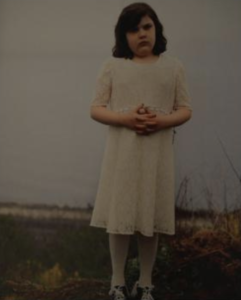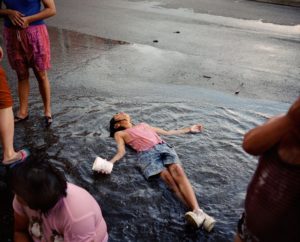By: Sarah Tewksbury, Editor-in-Chief
On the third floor of Portland Museum of Art (PMA), tucked away in the back corner in the William Dette Hamill Gallery, museum goers can stumble upon an exhibit dedicated to the innocence of childhood. The collection, titled Child’s Play: Representations of Adolescence, has been open to the public since July and will remain hanging until Dec. 17.
The collection of twentieth century photographs encompasses aspects of childhood. Some are obvious depictions of innocence and stereotypical youth activities, while others elicit more serious emotive notions from viewers. According to the PMA exhibit webpage, “This exhibition reveals artists’ awareness that the early years of life are marked by transition and transformation, and the meaning and experience of youth is hardly fixed. Representations of adolescence evoke many phases and moments including self-discovery, growth, nostalgia, playfulness, and sexual awakening. This exhibition explores the complexities of youth from multiple perspectives.”

When attendees first walk into the gallery, they are caught by the structured set up of the collection. Documentary style photographs housed in thin black frames are hung evenly around the square room with flawless glass covering the delicate art. Questioning the method and pattern of the layout of the content within the room finds viewers realizing that the layout of the exhibit reflects the sentiment of an adolescent’s emotions: sporadic and restless.
One of the more striking photograph pairs, hanging next to one another near a doorway, is of a color photo capturing a young girl laying in a puddle next to a black and white image of a child preparing for their first communion. The child posing in the puddle is titled Girl in Rain, Chicago and was taken by Paul D’Amato in 1991. The girl is relaxed, with her legs crossed casually, looking up at the sky. The image narrates a tone of acceptance and commands the sentiment of serenity. Beside D’Amato’s creation, First Communion from 1962 contrasts the carefree nature of the colorful image. Rigidity resonates with viewers observing the child, frozen within the photo for eternity.

Another compelling duo hangs at the entrance to the gallery. Two portraits hang side by side on a wall end, one titled Black Boy taken by Todd Webb in 1942, the other called Young Boy taken by Paul Strand in 1951. Though the photographs were captured only nine years apart, they seem as though they were taken in different worlds altogether. Black Boy is printed and cut to show an image roughly six inches by six inches. Zoomed in on only the child’s face, Webb’s portrait highlights a specific facial expression of tired confusion. Young Boy, taken in France, shows strength and defiance. The young man in the image has a stony look on his face that bores into viewers. The soulful look in both boys’ eyes is telling and haunting. With similar emotions expressed in their eyes but very different facial contortions, they are an unlikely pair who tell a compelling story. As a commentary on being an adolescent, these two images work together to show how different countries, stories, heritages and lives for two boys can produce the same expressive eyes. Though the two boys in the images are not connected in any social or practical way, they are connected by their experience with age.
Though a significant portion of the work on display focused on the more serious perspective of the world of an adolescent two images stood out to illicit humor and love. Melonie Bennett’s 1993 photograph, The Boys Experiencing What it Would be Like to Have Cleavage, shows four teenaged boys sitting at a dining room table, littered with playing cards and soda cans. None of them are wearing shirts–but they are wearing bras. The image seized a moment in the boys’ lives that is enough to remind any adult the curiosity and hilarity of growing up. In 1987, Sally Mann took a series of photos titled At Twelve, Portraits of Young Women. One of the images is hanging among the current exhibit in PMA and is untitled, yet powerful. According to the PMA descriptive card beside the frame, a young girl “caught in a liminal moment between childhood and adolescence” is sitting on a man’s lap looking back at the camera. The love and innocence radiating off of the girl is enough to stop any museum goer in their tracks.
Closure from the gallery’s contents comes for viewers in the form of self reflection. The emotions evoked by the children in the room are unavoidable. Well worth the visit, PMA’s collection of young men and women allow, for even the shortest of times, observers to be transported to a time in their lives when they felt the same emotions displayed in the eyes of the subjects.

